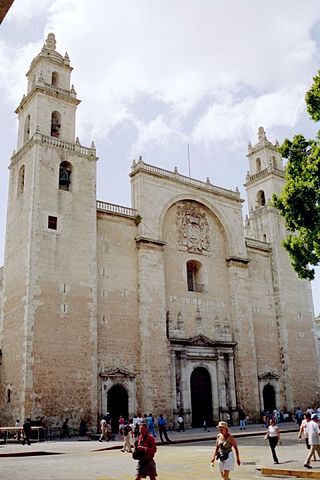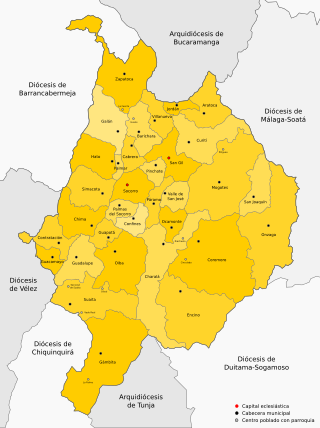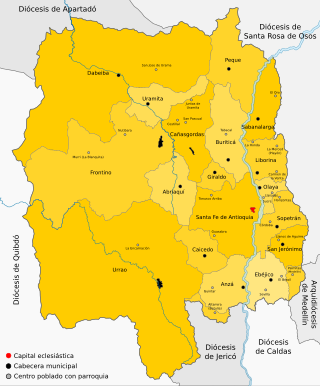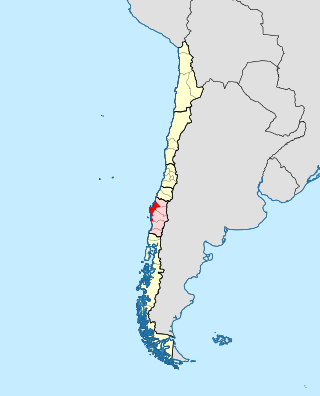History
On 25 September 1835, Pope Gregory XVI established the Diocese of Nueva Pamplona from the Metropolitan Archdiocese of Santafé en Nueva Granada. It was then a suffragan of the Archdiocese of Bogotá. The first bishop, José Jorge Torres Estans, a native of Cartagena, ruled from 30 August 1837, to 17 April 1853, when he died at the age of 81, an exile in San Antonio del Fáchira, Venezuela. His successor, José Luis Niño, named vicar Apostolic, was consecrated in October, 1856, and also died an exile in San Antonio del Fáchira, 12 February 1864. The third bishop, Bonifacio Antonio Toscano, governed from 13 October 1865, to his retirement in 1873. He convoked the first diocesan synod, and assisted at the Provincial Council of New Granada in 1868 and at the First Vatican Council. Indalecio Barreto succeeded him 3 December 1874, and died 19 March 1875, at La Vega near Cúcuta. The Bishop of Panamá, Ignacio Antonio Parra, his successor, ruled from 8 June 1876, until his death, 21 February 1908. Bishop Parra had been exiled by the Liberal government from 1877 to 1878. Evaristo Blanco was transferred from the Diocese of Socorro, 15 August 1909. [1] It was elevated to an archdiocese on 29 May 1956.

The Roman Catholic Archdiocese of Yucatán is an archdiocese of the Catholic Church based in Mérida, Yucatán, Mexico. The diocese of Campeche, the diocese of Cancún-Chetumal and the diocese of Tabasco are its suffragans. Its area is that of the state of the same name, covering an area of 17,204 square miles.

The Diocese of Tui-Vigo is a Latin Church ecclesiastical territory or diocese of the Catholic Church in Northwestern Spain. It is a suffragan diocese in the ecclesiastical province of the metropolitan Archdiocese of Santiago de Compostela.

The Roman Catholic Archdiocese of Trujillo is an archdiocese located in the city of Trujillo in Peru.

The Roman Catholic Archdiocese of Durango is a Metropolitan Archdiocese in Mexico. Based in the city of Durango, it is the metropolitan see for the suffragan dioceses of Gómez Palacio, Mazatlán and Torreón as well as the Territorial Prelature of El Salto.

The Roman Catholic Archdiocese of Lima is part of the Catholic Church in Peru which enjoys full communion with the Holy See. The Archdiocese was founded as the Diocese of Lima on 14 May 1541. The diocese was raised to the level of a metropolitan archdiocese by Pope Paul III on 12 February 1546. One of its archbishops was the saint Torribio Mogrovejo.

The Archdiocese of Bogotá is a Latin Church ecclesiastical territory of the Catholic Church in Colombia. It was established in 1562 as the Diocese of Santa Fe en Nueva Granada, elevated to an archdiocese two years later, and was given its current name in 1891. It serves nearly 3.8 million Catholics in Bogotá and parts of the Cundinamarca Department, and covers a total area of 4,109 km2. The current metropolitan archbishop is Luis José Rueda Aparicio since 2020.
The Diocese of Almería is a Latin Church diocese of the Catholic Church located in the city of Almería in the ecclesiastical province of Granada in Spain.

The Diocese of Portalegre–Castelo Branco is a Latin Church diocese of the Catholic church in Portugal. It has carried this name since 1956, when the historical diocese of Portalegre was renamed. It is a suffragan of the archdiocese of Lisbon.

The Roman Catholic Archdiocese of Arequipa is an archdiocese located in the city of Arequipa in Peru. It was erected by Pope Gregory XIII on 15 April 1577 at the request of King Philip II of Spain.

The Roman Catholic Archdiocese of La Paz is an archdiocese located in the city of La Paz in Bolivia.

The Roman Catholic Diocese of Socorro y San Gil is a diocese located in the cities of Socorro and San Gil in the ecclesiastical province of Bucaramanga in Colombia.

The Roman Catholic Archdiocese of Cartagena is an archdiocese located in the city of Cartagena in Colombia.

The Roman Catholic Diocese of Cúcuta is a diocese located in the city of Cúcuta in the ecclesiastical province of Nueva Pamplona in Colombia.

The Roman Catholic Diocese of Pasto is a diocese located in the city of Pasto in the ecclesiastical province of Popayán in Colombia.

The Roman Catholic Archdiocese of Santa Fe de Antioquia is an archdiocese located in the city of Santa Fe de Antioquia in Colombia.

The Roman Catholic Archdiocese of Tunja is an archdiocese located in the city of Tunja in Colombia.

The Roman Catholic Archdiocese of Valencia en Venezuela is an archdiocese located in the city of Valencia in Venezuela.

The Roman Catholic Archdiocese of Concepción is an archdiocese located in the city of Concepción in Chile.

The Theological Seminary of Bogotá, commonly known as the Major Seminary of Bogotá is a Roman Catholic major seminary located in Bogotá, Colombia, and serving both the Archdiocese of Bogotá and the Diocese of Facatativá. With history dating back to 1581, it is the oldest seminary in the Americas, and today is the largest and most prominent seminaries in Colombia, with dozens of alumni having been appointed bishops, archbishops, and cardinals. In addition to religious leaders, two Colombian presidents have been associated with the seminary. José Manuel Marroquín, the 27th President of Colombia, studied there in the 1840s, and Miguel Abadía Méndez, who was president in the 1920s, taught Latin at the seminary in the early 20th century.
This page is based on this
Wikipedia article Text is available under the
CC BY-SA 4.0 license; additional terms may apply.
Images, videos and audio are available under their respective licenses.



















